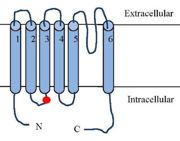Sandbox Reserved 1652
From Proteopedia
(Difference between revisions)
| Line 7: | Line 7: | ||
== Introduction == | == Introduction == | ||
| - | [https://en.wikipedia.org/wiki/TRPV1 TRPV1] (Vanilloid Transient Receptor Potential Type 1) is a non-selective ion channel which, in response to a stimulus, induces an incoming current of cations, primarily calcium and sodium, that causes depolarization of the cell. It is part of the [https://en.wikipedia.org/wiki/Transient_receptor_potential_channel TRP] (Transient Receptor Potential) superfamily and is the first in a subfamily of vanilloid-sensitive TRP channels: TRPVs.TRPV1 is expressed in | + | [https://en.wikipedia.org/wiki/TRPV1 TRPV1] (Vanilloid Transient Receptor Potential Type 1) is a non-selective ion channel which, in response to a stimulus, induces an incoming current of cations, primarily calcium and sodium, that causes depolarization of the cell. It is part of the [https://en.wikipedia.org/wiki/Transient_receptor_potential_channel TRP] (Transient Receptor Potential) superfamily and is the first in a subfamily of vanilloid-sensitive TRP channels: TRPVs.TRPV1 is expressed in [https://en.wikipedia.org/wiki/Group_A_nerve_fiber Group A nerve fiber] and [https://en.wikipedia.org/wiki/Group_C_nerve_fiber Group C nerve fiber] by sensory neurons of the dorsal and trigeminal spinal ganglia. (Gastrointestinal tract’s neurons express this receptor widely which may be involved in Crohn's disease. TRPV1 is also located on the heart peri vascularisation. It has a vasodilatation effect and protects this organ via the substance it releases.) TRPV1 is implicated in [https://en.wikipedia.org/wiki/Nociception nociception], its activation by heat or by chemical substances leads to a painful sensation.<ref name="TRPV1">Wikipedia contributors. (2020, december 21). TRPV1. Wikipedia. https://en.wikipedia.org/wiki/TRPV1 (Consulted the: dec. 28, 2020). [Online].</ref> Functional and structural studies of TRPV1 have contributed to a clearer understanding of transmission of nociceptive stimuli mechanisms especially with low diameter fibers. TRPV1 has a major role in inflammatory and pain sensitivity and overactivation of TRPV1 increases the sensitivity to pain as well as extended pain induces overexpression of TRPV1 in nerve fibers. However, sub-expression of this receptor induces chronic pain. Which can appear with abnormal neuromodulators transport due to axonal damage. |
TRPV1 can be indirectly activated by NGF (nerve growth factor) and specific molecules of the inflammatory system such as bradykinin, serotonin, histamin, prostaglandin or ATP. They increase the channel opening, by blocking the PIP2 inhibition or by decreasing the heat activation threshold. | TRPV1 can be indirectly activated by NGF (nerve growth factor) and specific molecules of the inflammatory system such as bradykinin, serotonin, histamin, prostaglandin or ATP. They increase the channel opening, by blocking the PIP2 inhibition or by decreasing the heat activation threshold. | ||
<ref name="TRPV1 dans les neuropathies douloureuses"> A. Danigo, L. Magy et C. Demiot , Med Sci (Paris) Volume 29, Number 6-7, Juin–Juillet 2013, p. 597-606. TRPV1 dans les neuropathies douloureuses, https://www.medecinesciences.org/en/articles/medsci/full_html/2013/08/medsci2013296-7p597/medsci2013296-7p597.html, (Consulted the : dec. 23, 2021). [Online].</ref> | <ref name="TRPV1 dans les neuropathies douloureuses"> A. Danigo, L. Magy et C. Demiot , Med Sci (Paris) Volume 29, Number 6-7, Juin–Juillet 2013, p. 597-606. TRPV1 dans les neuropathies douloureuses, https://www.medecinesciences.org/en/articles/medsci/full_html/2013/08/medsci2013296-7p597/medsci2013296-7p597.html, (Consulted the : dec. 23, 2021). [Online].</ref> | ||
Revision as of 09:54, 30 December 2021
| This Sandbox is Reserved from 26/11/2020, through 26/11/2021 for use in the course "Structural Biology" taught by Bruno Kieffer at the University of Strasbourg, ESBS. This reservation includes Sandbox Reserved 1643 through Sandbox Reserved 1664. |
To get started:
More help: Help:Editing |
The Transient Receptor Potential cation channel subfamily V member 1 TRPV1
| |||||||||||
References
- ↑ 1.0 1.1 1.2 Wikipedia contributors. (2020, december 21). TRPV1. Wikipedia. https://en.wikipedia.org/wiki/TRPV1 (Consulted the: dec. 28, 2020). [Online].
- ↑ 2.0 2.1 A. Danigo, L. Magy et C. Demiot , Med Sci (Paris) Volume 29, Number 6-7, Juin–Juillet 2013, p. 597-606. TRPV1 dans les neuropathies douloureuses, https://www.medecinesciences.org/en/articles/medsci/full_html/2013/08/medsci2013296-7p597/medsci2013296-7p597.html, (Consulted the : dec. 23, 2021). [Online].
- ↑ 3.0 3.1 3.2 3.3 3.4 3.5 Liao, M., Cao, E., Julius, D., & Cheng, Y. (2013b). Structure of the TRPV1 ion channel determined by electron cryo-microscopy. Nature, 504(7478), 107‑112. https://doi.org/10.1038/nature12822(consulté le déc. 28, 2020)
- ↑ T. Rosenbaum et S. A. Simon, « TRPV1 Receptors and Signal Transduction », in TRP Ion Channel Function in Sensory Transduction and Cellular Signaling Cascades, W. B. Liedtke et S. Heller, Éd. Boca Raton (FL): CRC Press/Taylor & Francis, 2007
- ↑ 5.0 5.1 5.2 5.3 5.4 G. Smutzer et R. K. Devassy, « Integrating TRPV1 Receptor Function with Capsaicin Psychophysics », Advances in Pharmacological Sciences, janv. 14, 2016
- ↑ R. Kumar, A. Hazan, A. Basu, N. Zalcman, H. Matzner, et A. Priel, « Tyrosine Residue in the TRPV1 Vanilloid Binding Pocket Regulates Deactivation Kinetics », J. Biol. Chem., vol. 291, no 26, p. 13855‑13863, juin 2016, doi: 10.1074/jbc.M116.726372.
- ↑ X. Yao, H.-Y. Kwan, et Y. Huang, « Regulation of TRP Channels by Phosphorylation », Neurosignals, vol. 14, no 6, p. 273‑280, 2005, doi: 10.1159/000093042
- ↑ F. Yang et J. Zheng, « Understand spiciness: mechanism of TRPV1 channel activation by capsaicin », Protein Cell, vol. 8, no 3, p. 169‑177, mars 2017, doi: 10.1007/s13238-016-0353-7.
- ↑ F. Yang et al., « Structural mechanism underlying capsaicin binding and activation of the TRPV1 ion channel », Nat. Chem. Biol., vol. 11, no 7, Art. no 7, juill. 2015, doi: 10.1038/nchembio.1835.
- ↑ F. Yang et al., « The conformational wave in capsaicin activation of transient receptor potential vanilloid 1 ion channel », Nat. Commun., vol. 9, no 1, Art. no 1, juill. 2018, doi: 10.1038/s41467-018-05339-6.
- ↑ 11.0 11.1 K. Elokely et al., « Understanding TRPV1 activation by ligands: Insights from the binding modes of capsaicin and resiniferatoxin », Proc. Natl. Acad. Sci., vol. 113, no 2, p. E137‑E145, janv. 2016, doi:10.1073/pnas.1517288113.
- ↑ <ref>John Joseph, L. Qu, S. Wang, M. Kim, D. Bennett, J. Ro, M. J. Caterina and MK. Chung, Journal of Neuroscience 11 December 2019, 39 (50) 9954-9966. https://www.jneurosci.org/content/39/50/9954 (Consulté le: déc. 23, 2021). [En ligne].</li> <li id="cite_note-12">[[#cite_ref-12|↑]] K. W. Ho, N. J. Ward, et D. J. Calkins, « TRPV1: a stress response protein in the central nervous system », Am. J. Neurodegener. Dis., vol. 1, no 1, p. 1‑14, avr. 2012.</li> <li id="cite_note-13">[[#cite_ref-13|↑]] G. Bhave et al., « Protein kinase C phosphorylation sensitizes but does not activate the capsaicin receptor transient receptor potential vanilloid 1 (TRPV1) », Proc. Natl. Acad. Sci., vol. 100, no 21, p. 12480‑12485, oct. 2003, doi: 10.1073/pnas.2032100100.</li> <li id="cite_note-TRPV1_dans_les_neuropathies_douloureuses_-_Des_mod.C3.A8les_animaux_aux_perspectives_th.C3.A9rapeutiques-14">↑ <sup>[[#cite_ref-TRPV1_dans_les_neuropathies_douloureuses_-_Des_mod.C3.A8les_animaux_aux_perspectives_th.C3.A9rapeutiques_14-0|15.0]]</sup> <sup>[[#cite_ref-TRPV1_dans_les_neuropathies_douloureuses_-_Des_mod.C3.A8les_animaux_aux_perspectives_th.C3.A9rapeutiques_14-1|15.1]]</sup> A. Danigo, L. Magy, et C. Demiot, « TRPV1 dans les neuropathies douloureuses - Des modèles animaux aux perspectives thérapeutiques », médecine/sciences, vol. 29, no 6‑7, Art. no 6‑7, juin 2013, doi: 10.1051/medsci/2013296012.</li></ol></ref>


